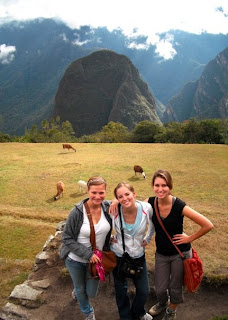Wow what a crazy week! Parciales week (midterms) is coming to an end and I am finally getting to post some pictures of our Cuzco trip from 2 weekends ago. Here's the sad news.. my camera died the day that we arove in Cuzco and of course i did not bring my charger with me. Definately an Amanda move but what are you going to do? Fortunately we are in the age of facebook where you can access all of your friends' photos and steal them by saving them on your own computer :). I found this to be almost even better than taking my own pictures because, while everyone was living through the lense, I was camera free and taking in the sights like a dry sponge.
Cuzco is an absolutely gorgeous city... much more so than Lima in my personal opinion (and almost anyone you will talk to will agree). It is "touristy" but this makes for a really great place to meet people from all over the world!
For some reason I am not able to put captions with pictures on this blog.. first I have included a couple of pictures of the city itself. It has a very colonial feel.
On our first day in Cuzco we visited an alpaca/llama farm/petting zoo. Here we got to feed the animals and then see how they make the wool, clothing, and other soft things. On this farm they use all natural ingredients to dye the wool. Here is a dirty little secret: to make the yellow wool human urine is the dye.
On the day that we visited Machu Picchu we woke up at 4:00a.m. to climb the mountain instead of the more conventional bus ride. This consists of walking up a staircase of very large rocks for about an hour. When we began our walk it was pitch dark and all we could see was a faint outline of the mountains and a heavy mist all around us. It was an eerie yet magical feeling. I have included a couple of pictures of the hike up in the morning as well as some pictures of Machu Picchu.
Later we climbed to the top of Huayna Picchu (the mountain in the middle of all of the postcard pictures of Machu Picchu). We opted to climb up a little later since we were so exhausted from the morning hike. This was an excellent decision as we got to enjoy the ruins free of massive groups of tourists as well as watch the sunrise. Huayna Picchu is quite the hike but after our Machu Picchu hike it seemed like nothing. There was a dog that followed us all the way up Huayna who we affectionately named Buster (pronounced Booster). He would run up a few steps, lay down to rest while we caught up and then continue on his way.
Overall, best trip thus far. Pictures do not do justice. You will have to come visit me :)






























































